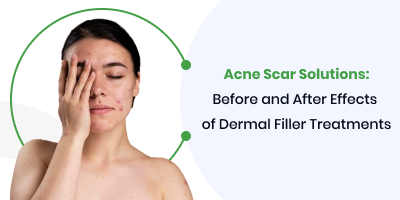
Contents
Every scar tells a story, but when it comes to acne scars, those stories can echo through time, affecting not just the skin, but one’s self-assurance. While there are various treatments available, dermal fillers have emerged as a promising solution for acne scars. Once reserved for the pursuit of youth, they now play a pivotal role in the restoration of skin marred by acne’s touch.
Do dermal fillers erase marks? What is the longevity of the effect? What types of scars can be treated? This theme has many questions. You’ll find all the answers in the article. Let’s discover one by one.

A dermal filler is a cosmetic injectable substance. Usually, they are employed to reduce signs of aging, improve contours, and add volume.
Dermal fillers for acne scars provide a nonsurgical and minimally invasive option. These treatments provide a quick result in a short period and are relatively painless. Many studies report a positive effect on acne scarring after dermal filler injections.
There are several types of dermal fillers to treat acne scars. Each of them has unique properties and is suited for specific scar types and patient preferences.
The choice of dermal filler type depends on the type of acne scars, the patient’s skin type, and individual treatment goals.
Dermal filler treatments have proven to be a remarkable solution for individuals seeking to address various skin imperfections, including deep acne scars. The transformative effects of dermal fillers are often best understood through the visual evidence of before and after photographs.
Before undergoing dermal filler treatment, individuals with deep acne scars may experience noticeable depressions, irregularities, and textural discrepancies in their skin. These scars can often lead to feelings of self-consciousness and may impact overall confidence.
After dermal filler injections, the skin undergoes an improvement in texture and complexion. The filler is carefully injected into the scarred areas. It fills and lifts the depressions, creating the desired result, smooth skin.
In the before and after images, the positive changes are evident. Deep acne scars become less pronounced, and the skin regains a rejuvenated appearance. The overall effect is a more youthful, vibrant, and confident complexion.
Understanding the various types of acne scars is crucial in determining the most effective treatment approach. From narrow, pitted ice pick scars to broader, shallow rolling scars, each type poses unique challenges. We explore the distinct characteristics of the different acne scars and delve into the available treatment options.
They are narrow, deep pits in the skin that resemble the marks left by an ice pick or needle. Such acne scars are small but can be quite deep.
Treatment options:
Potential Dermal Fillers:
Such acne scars have sharp, well-defined edges and are wider than ice pick scars. They resemble chicken pox scars.
Treatment options:
Potential Dermal Fillers:
It’s a type of acne scars characterized by broad, shallow indentations in the skin with sloping edges. They create a wavy or undulating appearance on the skin’s surface. Rolling scars are caused by damage to the skin’s collagen fibers, which results in a loss of elasticity and uneven texture.
Treatment options:
Potential Dermal Fillers:
These are types of raised scars that result from an overproduction of collagen during the healing process. While both are similar in appearance, keloids extend beyond the original wound site and can be more severe.
Treatment options:
Potential Dermal Fillers:
While dermal fillers are not used to treat hypertrophic acne scars or keloids, they can be employed to smooth uneven skin texture around the scarred area.
Note that any treatment plan should be carefully considered and discussed with a healthcare professional or dermatologist.
Dermal fillers work on acne scars by addressing the depression and unevenness caused by the loss of tissue and collagen associated with scarring.
It’s important to understand that while dermal fillers can be highly effective in improving the appearance of certain types of acne scars, they may not be suitable for all scar types or individuals. Consulting with a qualified dermatologist or healthcare provider is essential to determine the best approach for each unique case.
Additionally, multiple sessions may be required for optimal results, and maintenance treatments may be necessary to sustain improvements over time.
While dermal filler treatments for acne scars are generally considered safe and effective, they can be associated with potential side effects. It’s vital to be aware of these possible outcomes, although they tend to be temporary and manageable.
Always seek immediate medical attention if you experience severe or concerning side effects after dermal filler injections.
Before any acne scar treatment, a comprehensive evaluation of the patient’s medical history must be done. This step gives the characteristics of an individual’s overall health. It guides the practitioner in making informed decisions. Contradictions are allergic reactions to filler components or lidocaine, active infection, pregnancy and breastfeeding patients, autoimmune or bleeding disorders, and recent facial procedures.
Selecting the right plan for acne scar treatment involves careful consideration of several factors. Here are steps to guide you through the decision-making process:
Remember, the right acne scars treatment plan will be unique to your specific needs and preferences. Take time to consult with a trusted provider and collaborate in making the best decision for achieving smoother, more radiant skin.
In closing, dermal fillers emerge as a powerful tool in the realm of acne scar treatment and facial rejuvenation. While not offering permanent results, they present a substantial and enduring improvement in skin texture and appearance. With effects often lasting up to a year, and potential for even greater longevity with proper aftercare, dermal fillers offer renewed hope to those seeking to diminish the impact of acne scars.
It is our sincere recommendation to consult with your healthcare provider to explore the transformative potential of dermal fillers for acne scar treatment. Say goodbye to the lingering effects of past blemishes and welcome a smoother, more radiant complexion.
or those in search of facial fillers for their medical practice, MedEuroStore stands as a trusted source to buy dermal fillers online. Just remember to ensure the necessary licensing for your order. With that, we conclude this article, grateful for your presence in our blog. Thank you for reading this article!